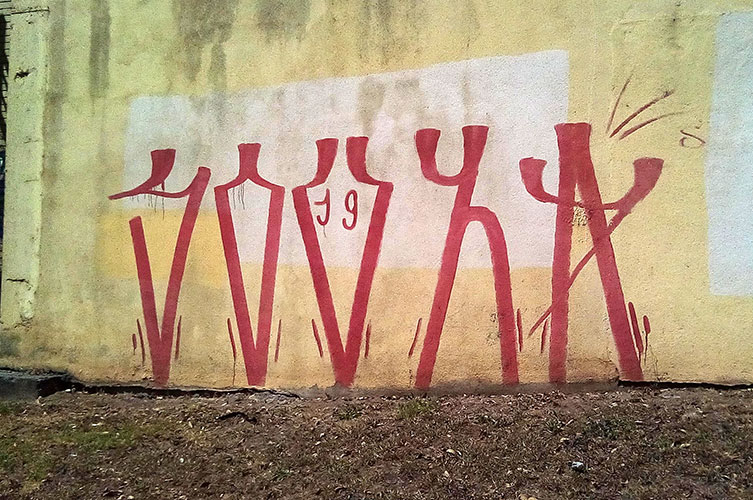Art, // December 19, 2022
Street Art/Graffiti — ART
Parietal paintings come from prehistoric times. Ever since Man has known himself as Man, he has had the need to represent what he sees, of course initially out of a sense of possession – the image brought him closer to the object -, later Man starts to decorate the walls and ceilings for simple delight, the the greatest example of all are the frescoes by Michelangelo’s – Sistine Chapel. In the last century walls and blind walls were an affirmation of a culture account, the marking of territory or just the pleasure of doing something forbidden, the adrenaline of risk, who doesn’t remember the CP carriages in Portugal., and many other examples that when we remember it make us shiver and wonder how they had the courage. Today it is a way of life, recognized and appreciated by everyone, or almost everyone.
But how to understand this phenomenon, there is no. (according to my point of view) It’s a mystery of the unconscious, the need we have to scribble, we could say they didn’t know how to write and this was the way they found to communicate and today?! The truth is that we haven’t stopped engraving on the walls, we’ve just been transforming and adapting the type and theme of representation, and, incredible as it may seem, the base and the support are always the same, otherwise let’s see:
Rock art are artistic representations: animals, plants, people and abstract symbols, most of the time difficult to interpret, made on walls and ceilings in prehistoric times; fresco, a technique used by the Greeks and Romans, some to tell ancient chronicles, others as irony and a political weapon, is a pictorial work in mortar or plaster and made where? on walls and ceilings, and on murals (what we call blind walls today) we are talking about the 5th century BC; 20th century (1970s), graffiti from the Italian graffiti, which means writing made with charcoal, which is nothing more nor less than artistic representations: animals, plants, people and abstract symbols, most of the time difficult to interpret (no. I wasn’t mistaken, it really is a copy of rock art), carried out on walls, walls and even on the ground.
The practice of graffiti emerged in Paris and New York. In Paris, it became widespread from 1968 onwards, when the walls of Paris were transformed into political flyers – a movement known as “May 68”-, in New York it is associated with hip hop culture, (only As a curiosity of hip-hop derive 3 artistic currents: rap, associated with music; breakdance linked to dance and graffiti, mural painting, illegal and considered an act of vandalism).
From the walls of the Bronx (where graffiti was born in the neighboring city of New York, as a form of protest. The Latino, African-American and Jamaican communities used mural painting as a form of protest and to call the attention of the authorities to the miserable living conditions in residential neighborhoods, the racism they were victims of and still are; having been used by the “gangs” as a marking of territory) quickly invaded the New York subway and from here to the world it was a magical step.
Almost 20 years later, he arrives in Portugal, more precisely at the walls of the secondary school in Carcavelos, in the municipality of Cascais, the birthplace of graffiti, in 1988 by the hands of graffiti artist Nomen. From “act of” vandalism to Urban Art, what is art and what is vandalism? Is it all graphics or not?
Yes, because there are two types of inscriptions, some with drawings, logos, phrases, others with images, some even reproduce paintings by well-known artists or icons of local cultures. Graffiti, is urban art, and is the whole parietal work with images (drawings), phrases, scribbles, insults, tags (signatures), declarations of love, summarizing writing, it’s called pichação and this is indeed an act of vandalism.
With the interest of art galleries and the public, they moved from anonymous artists to the covers of newspapers, being hired by City Councils, event organizers, public bodies, among others. Car repainting cans have given way to a spray industry, where it is not enough to just have the can, you also need a series of accessories: canvas for painting on the floor, aerosol, mask and protective gloves, stencil holders for making circles, palette guitar or a thin and flexible piece of nylon to compose trees, space cities, among others, sponge, stylus, foam brushes, pilot pen, and many others depending on the design; and there is the creation of tourist itineraries of urban art (Portugal) in cities such as Leiria, Figueira da Foz, Aveiro, Estarreja, Viseu, Covilhã and of course Cascais.
Olívia Rodrigues da Costa
Olívia da Costa é o nosso correspondente de artes para a Arts Illustrated em Portugal.
Facebook: https://www.facebook.com/omgmrc/
Instagram: https://www.instagram.com/olivia_maria_da_costa/
Linkedin: https://www.linkedin.com/in/ol%C3%ADvia-da-costa-1826723b/
Photographs by Olívia Rodrigues da Costa: Taken in the city of Amadora, Lisbon, Portugal



